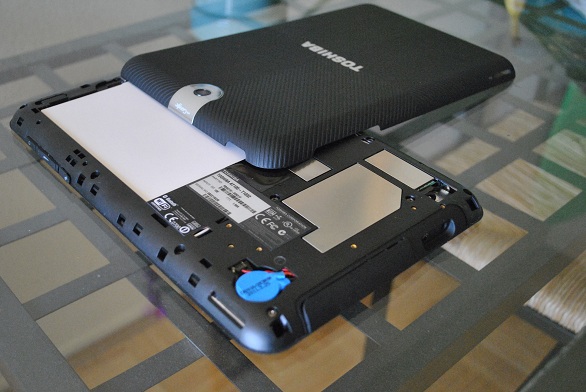By nearly every measure, the Toshiba Thrive is an unremarkable Android Honeycomb tablet. It’s fat, it’s heavy, and it’s got pretty much the same hardware as its peers.
And yet, the Thrive—available now starting at $429 for an 8 GB model—is different. That’s because Toshiba had the sense to pack this 10-inch tablet with all the jacks and ports that geeks have been asking for in a slate since, well, the original iPad. Connectivity is the Thrive’s standout feature, and that goes a long way toward redeeming this tablet’s shortcomings.
(MORE: Toshiba Thrive Is a $429 Android Tablet, Launching in July)
Toshiba’s Thrive is laughably thick next to an iPad 2 or Samsung Galaxy Tab 10.1, and still noticeably thicker than an original iPad. It’s also rather tall, partly due to its widescreen 10.1-inch display, but also because the top and bottom bezels each measure about an inch long. The frame has some flex to it, to the point that I could distort the screen by pushing up from the Thrive’s back panel.
Toshiba’s not taking home any awards for aesthetics, either. The front panel has three totally unnecessary indicator lights toward the top-right corner for power, charge and Wi-Fi—information already conveyed by the Android software—and a tacky-looking metallic strip loops around the device’s top edge, housing front- and rear-facing cameras.
The back side of the Thrive is covered in ridged plastic that’s easy to grip but tough on the eyes. This panel can be removed to access a replaceable battery or swapped out for more colorful plates that are sold for $20 each.
In short, consider the Toshiba Thrive’s design to be an extreme case of function over form, because this tablet is loaded with ports.
article continues on next page…
Peel away a piece of the Thrive’s bottom edge, and you’ll find inputs for full-size USB, full-size HDMI and mini USB. Around the corner on the Thrive’s bottom right side is a full-sized SD card slot. Only one other Android tablet–Acer’s Iconia Tab A500–comes close to these connectivity options, but it uses microSD and micro-HDMI instead of full-sized slots.
Thanks to Android 3.1’s support for all kinds of external devices, the Thrive’s many inputs open a lot of doors. You can hook up an external monitor via HDMI and use a USB mouse-keyboard combo to create an Android desktop PC. You can pop in your camera’s SD card and transfer photos to an external USB drive. Or my personal favorite: You can connect the Thrive to an HDTV and use a wired Xbox 360 controller to play old-school video game emulators on the big screen.
The only use that gave me trouble was Honeycomb’s YouTube app through HDMI, which was unable to play in full screen for some reason. Also, odd as this sounds, Android itself could use a little more attention to the mouse. Some basic right-click functions and the ability to drag-and-highlight would turn Honeycomb tablets into productivity powerhouses.
A couple other hardware nitpicks: Scan lines are noticeable on the Thrive’s 1280-by-800 resolution display, especially against light backgrounds, and the rear-facing camera lacks flash, so don’t expect great photos in low lighting.
(LIST: Tablets: ‘Why Should Somebody Buy This Instead of an iPad?’)
As for software, this is Android Honeycomb as usual, plus a bloatware situation that’s out of control.
Toshiba has its own storefronts for apps and books, but provides no obvious reason why you should use them instead of Google’s own offerings, which are also on the device. There’s a big bundle of random game demos, a trial version of Kaspersky anti-virus and a pre-loaded version of subscription music service MOG. An app called PrinterShare seems useful, but it only lets you print 5 pages for free. LogMeIn is a cool remote desktop service, but it’s limited to a 45-day trial. The only bundled software that’s truly helpful and not just a demo is Toshiba’s file manager, which helps if you’re planning to deal with lots of external storage. Of course, you can’t delete any of this stuff.
I didn’t notice any glaring performance issues with the Thrive’s dual-core Nvidia Tegra 2 processor, at least after applying a non-mandatory firmware update that was available out of the box. Android ran smoothly in its native landscape mode, but framerates suffered on the home screen when holding the tablet in portrait mode.
Android 3.1 grew on me during my time with the Thrive. It doesn’t have nearly as many wonderful tablet apps as the iPad, but we’re starting to see some good ones, like Plume (a Twitter client), Pulse reader, News360 and the super-complex space RPG Vendetta Online. And as with all Android tablets, the ability to create a collage of widgets makes for a nice little command center on the home screen.
Inevitably, another company will out-design Toshiba’s Thrive without sacrificing connectivity. Hopefully, Toshiba is planning for that outcome and is working on a thinner, lighter, nicer-looking Android tablet that still includes a PC-like set of ports. Until that day comes, the Toshiba Thrive is the most utilitarian tablet you’ll find.
Second Opinions:
CNET | PCWorld | PC Magazine | Digital Trends | Wall Street Journal


